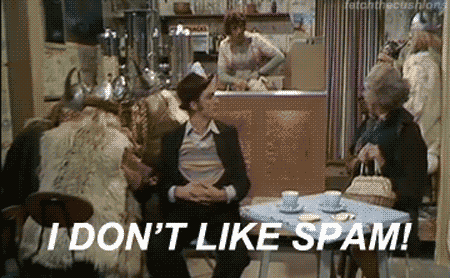Spam.
Nobody likes spam.
You’re probably an email wizard who sends and receives tons of emails yourself, but even you (especially you!) don’t like spam.
Throughout the history of people’s relationship with the internet and email, few things have proven as enduringly annoying as spam. This is why we have spam filters, and why so many spam filters are now so sophisticated and successful.
But sometimes those powerful filters block messages that aren’t spam, and this can be an expensive problem for nonprofits who plan a portion of their programs or budgets around the response they expect to get from the emails they send. The last thing you want after pouring tons of hard work and strategy into a campaign is to have your email snapped up by a filter simply because it contained something that made a filter think it was spam.
You already know that a sure way to trigger spam filters is through the use of particular language and phrasing – 100% FREE Viagra! Act NOW!!! Limited time offer…etc. What you may not know is that there are also design factors that can increase the “spam score” given to an email. This three-part blog series discusses some of these design triggers along with our recommendations for how to avoid problems.
First up: Image to Text Ratio
The need to balance the amount of imagery and text included in your email is widely agreed upon. Too many images and too little text is long said to be the most common way that an email’s design can trigger a spam filter
Designing an email as one large image (a bad practice for several reasons) can also trigger spam filters; since filters are unable to “read” images the same way text is read, many may assume it is an attempt to circumvent the filter and thus will treat it as spam.
A common standard for optimal email design is roughly 60 percent text to 40 percent imagery. This being said, it is worth noting in 2014 spam reporting tests were conducted which indicated the image/text ratio now has less of an impact on deliverability than previously assumed. The results showed that for emails containing 500 characters or more (it is uncommon for an email to contain less), the image/text ratio did not have a significant effect on spam filtering. These results, however, shouldn’t outweigh the other benefits of achieving a good balance of images and text in your email.
Because compelling images are so much more engaging than simple text, particularly for fundraising campaigns, our recommendation is to aim for the 40 percent imagery standard while remaining aware of the following:
- Image files must be web optimized (72ppi, smallest possible file size, etc.)
- A large percentage of email readers block images by default
- Specific alt text should be defined for each image in the html
- Some email clients can display styled alt text, use this to your advantage!
Check out “The Ultimate Guide to Email Image Blocking” from Litmus for more great advice on this topic.

